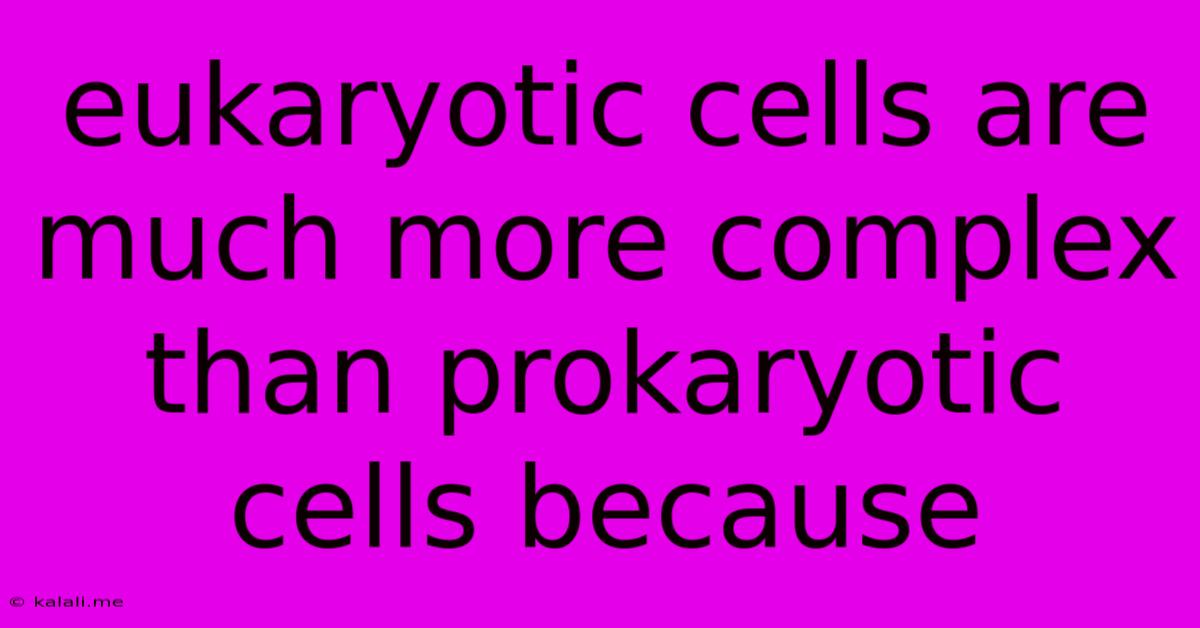Eukaryotic Cells Are Much More Complex Than Prokaryotic Cells Because
Kalali
Jun 15, 2025 · 3 min read

Table of Contents
Eukaryotic Cells: A Deep Dive into Complexity Compared to Prokaryotes
Eukaryotic cells are significantly more complex than their prokaryotic counterparts. This complexity arises from a range of structural and functional differences, impacting everything from cellular organization to genetic regulation. This article will explore the key distinctions that make eukaryotic cells far more intricate and sophisticated biological entities. Understanding these differences is crucial for appreciating the diversity and evolution of life on Earth.
The Defining Feature: Membrane-Bound Organelles
The most striking difference lies in the presence of membrane-bound organelles within eukaryotic cells. Prokaryotes, such as bacteria and archaea, lack these specialized compartments. Instead, their cellular processes occur within the cytoplasm. Eukaryotes, however, utilize these organelles to compartmentalize metabolic pathways, enhancing efficiency and preventing conflicts between different reactions. This sophisticated organization is a hallmark of eukaryotic complexity. Key organelles include:
- Nucleus: Houses the cell's genetic material (DNA) and controls gene expression, a vastly more regulated process than in prokaryotes.
- Mitochondria: The "powerhouses" of the cell, generating ATP (adenosine triphosphate), the cell's energy currency, through cellular respiration.
- Endoplasmic Reticulum (ER): A network of membranes involved in protein synthesis, folding, and modification, and lipid metabolism. The rough ER is studded with ribosomes, while the smooth ER lacks them.
- Golgi Apparatus: Processes and packages proteins and lipids for transport within or outside the cell.
- Lysosomes: Contain enzymes that break down waste materials and cellular debris.
- Vacuoles: Store water, nutrients, and waste products. Plant cells often have a large central vacuole.
- Chloroplasts (in plant cells): Conduct photosynthesis, converting light energy into chemical energy.
Genome Organization and Gene Regulation: A Tale of Two Cells
Eukaryotic genomes are significantly larger and more complex than prokaryotic genomes. Eukaryotic DNA is linear and packaged with proteins called histones to form chromatin, which further condenses into chromosomes during cell division. This intricate organization allows for precise control of gene expression. Prokaryotic DNA, on the other hand, is circular and typically lacks histone proteins. Gene regulation in prokaryotes is simpler, often involving operons that control the expression of multiple genes simultaneously. Eukaryotic gene regulation is far more nuanced, involving a complex interplay of transcription factors, RNA processing, and post-translational modifications.
Cytoskeleton: Providing Structure and Movement
Eukaryotic cells possess a complex cytoskeleton, a network of protein filaments (microtubules, microfilaments, and intermediate filaments) that provides structural support, facilitates intracellular transport, and enables cell movement. While prokaryotes have some cytoskeletal elements, the eukaryotic cytoskeleton is far more elaborate and dynamic, enabling processes such as cell division, cell migration, and changes in cell shape.
Cell Size and Surface Area to Volume Ratio
Eukaryotic cells are generally larger than prokaryotic cells. This size difference has implications for the surface area to volume ratio. Larger cells have a lower surface area to volume ratio, potentially limiting the efficiency of nutrient uptake and waste removal. Eukaryotes overcome this challenge through the compartmentalization provided by their membrane-bound organelles and the efficient transport systems facilitated by the cytoskeleton.
Cellular Reproduction: Mitosis and Meiosis
Eukaryotic cells undergo mitosis and meiosis, complex processes that ensure accurate chromosome segregation during cell division. Mitosis produces genetically identical daughter cells, while meiosis generates genetically diverse gametes (sex cells). Prokaryotic cell division, on the other hand, is simpler, involving binary fission.
In conclusion, the intricate network of membrane-bound organelles, the sophisticated genome organization and gene regulation mechanisms, the complex cytoskeleton, and the more elaborate cellular division processes all contribute to the significantly greater complexity of eukaryotic cells compared to their prokaryotic counterparts. This complexity underpins the remarkable diversity and adaptability of eukaryotic organisms, ranging from single-celled protists to multicellular plants and animals.
Latest Posts
Latest Posts
-
How Can I Become A Secret Agent
Jun 15, 2025
-
Oxidation Number Of Oxygen In Of2
Jun 15, 2025
-
What Is The Lcm Of 6 And 24
Jun 15, 2025
-
The Number Of Cycles Per Second Is Called
Jun 15, 2025
-
The Blank Defended The Benefits Of Economic Development
Jun 15, 2025
Related Post
Thank you for visiting our website which covers about Eukaryotic Cells Are Much More Complex Than Prokaryotic Cells Because . We hope the information provided has been useful to you. Feel free to contact us if you have any questions or need further assistance. See you next time and don't miss to bookmark.